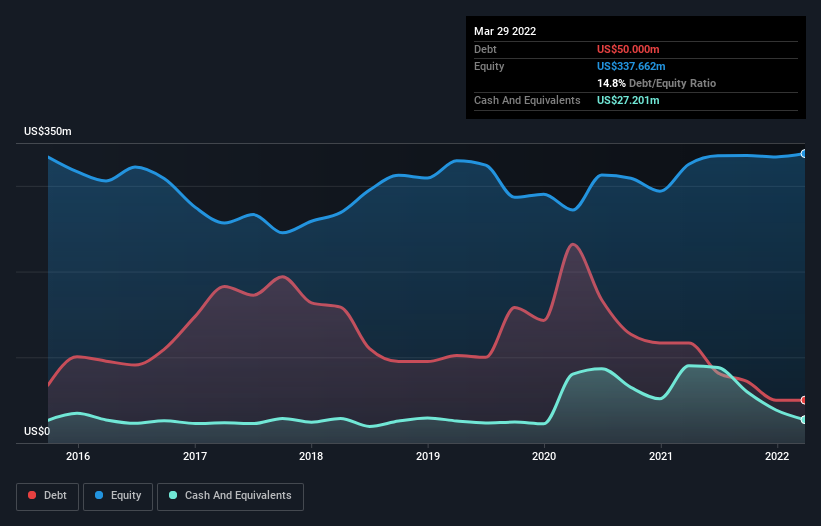
David Iben put it well when he said, 'Volatility is not a risk we care about. What we care about is avoiding the permanent loss of capital.' So it seems the smart money knows that debt - which is usually involved in bankruptcies - is a very important factor, when you assess how risky a company is. Importantly, BJ's Restaurants, Inc. (NASDAQ:BJRI) does carry debt. But should shareholders be worried about its use of debt?
When Is Debt Dangerous?
Debt is a tool to help businesses grow, but if a business is incapable of paying off its lenders, then it exists at their mercy. Ultimately, if the company can't fulfill its legal obligations to repay debt, shareholders could walk away with nothing. While that is not too common, we often do see indebted companies permanently diluting shareholders because lenders force them to raise capital at a distressed price. Of course, plenty of companies use debt to fund growth, without any negative consequences. When we examine debt levels, we first consider both cash and debt levels, together.
Check out our latest analysis for BJ's Restaurants
What Is BJ's Restaurants's Net Debt?
The image below, which you can click on for greater detail, shows that BJ's Restaurants had debt of US$50.0m at the end of March 2022, a reduction from US$116.8m over a year. However, because it has a cash reserve of US$27.2m, its net debt is less, at about US$22.8m.

How Healthy Is BJ's Restaurants' Balance Sheet?
We can see from the most recent balance sheet that BJ's Restaurants had liabilities of US$185.7m falling due within a year, and liabilities of US$496.7m due beyond that. Offsetting this, it had US$27.2m in cash and US$24.1m in receivables that were due within 12 months. So it has liabilities totalling US$631.1m more than its cash and near-term receivables, combined.
When you consider that this deficiency exceeds the company's US$540.3m market capitalization, you might well be inclined to review the balance sheet intently. In the scenario where the company had to clean up its balance sheet quickly, it seems likely shareholders would suffer extensive dilution. The balance sheet is clearly the area to focus on when you are analysing debt. But ultimately the future profitability of the business will decide if BJ's Restaurants can strengthen its balance sheet over time. So if you want to see what the professionals think, you might find this free report on analyst profit forecasts to be interesting.
In the last year BJ's Restaurants wasn't profitable at an EBIT level, but managed to grow its revenue by 55%, to US$1.2b. Shareholders probably have their fingers crossed that it can grow its way to profits.
Caveat Emptor
Despite the top line growth, BJ's Restaurants still had an earnings before interest and tax (EBIT) loss over the last year. To be specific the EBIT loss came in at US$12m. When we look at that alongside the significant liabilities, we're not particularly confident about the company. It would need to improve its operations quickly for us to be interested in it. On the bright side, we note that trailing twelve month EBIT is worse than the free cash flow of US$3.3m and the profit of US$995k. So one might argue that there's still a chance it can get things on the right track. When analysing debt levels, the balance sheet is the obvious place to start. However, not all investment risk resides within the balance sheet - far from it. For example, we've discovered 1 warning sign for BJ's Restaurants that you should be aware of before investing here.
When all is said and done, sometimes its easier to focus on companies that don't even need debt. Readers can access a list of growth stocks with zero net debt 100% free, right now.
Valuation is complex, but we're here to simplify it.
Discover if BJ's Restaurants might be undervalued or overvalued with our detailed analysis, featuring fair value estimates, potential risks, dividends, insider trades, and its financial condition.
Access Free AnalysisHave feedback on this article? Concerned about the content? Get in touch with us directly. Alternatively, email editorial-team (at) simplywallst.com.
This article by Simply Wall St is general in nature. We provide commentary based on historical data and analyst forecasts only using an unbiased methodology and our articles are not intended to be financial advice. It does not constitute a recommendation to buy or sell any stock, and does not take account of your objectives, or your financial situation. We aim to bring you long-term focused analysis driven by fundamental data. Note that our analysis may not factor in the latest price-sensitive company announcements or qualitative material. Simply Wall St has no position in any stocks mentioned.
About NasdaqGS:BJRI
Adequate balance sheet and fair value.


